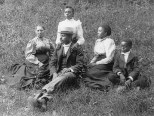|
|
 |
 |
|
Reading Guide |
| 8. |
Family
| - | Alice Dunbar-Nelson, "The Stones of the Village," short story, ca. 1905 |
| - | Photographs of African American families, 1870s-1910s, from Digital Schomburg |
|
|
Du Bois/LOC 
Georgia family, 1899 or 1900 |
During this period, for the formerly enslaved populations of the South, the family, for the first time, became an institution that could be reliably counted on to communicate the legacy of one generation to the next. No longer did African Americans in the South live with the fear that the slave economy would sever generational ties by selling husbands, wives, sons, daughters, brothers, and sisters to distant plantations. Even so, between 1865 and 1917, stories focusing primarily on African American family life are rare. Family concerns, if they appear in African American fiction at all, are usually subtexts, as they are in "The Stones of the Village." It would seem that the goal orientation of African American literature at this time caused authors to emphasize social and political issues above those of family. This was true for memoirists as well as fiction writers. Note how little Washington has to say about family in Up from Slavery.
Nonetheless, family is an important theme in "The Stones of the Village." The story illustrates the role of the family by depicting what happens when a person does not have one. Victor Grabért, the protagonist, is a black man, whose birth family is represented only by his grandmother. Passing for white in New Orleans, he cannot embrace even that lone family connection. He illustrates the point Du Bois makes in "The Talented Tenth" that the "Negro people" had "no traditions . . . no long established customs, no strong family ties." Grabért agonizes over his lack of family nearly as much as he does over the secret of his racial identity. He envies his white wife, whose "half a hundred cousins and uncles and aunts" keep her in "touch with the world." He possesses everything that other men of his class possess except "family traditions," and that deficiency makes "his life a misery." His crowning achievement, he believes, would be to found a dynasty. (One may think of the work of William Faulkner at this point.) "The Stones of the Village" does double duty in the Toolbox, for it also appears among the resources of the Identity section.
If "The Stones of the Village" illustrates Du Bois's point about black family traditions at this time, the images from the Digital Schomburg collection challenge it. Here we see people asserting family ties and generational connections. Some of the photos seem almost didactic in their determination to show future family members precisely what they have inherited. Note the way the photo captions contextualize the pictures. Excellent teaching tools. 21 pages.
Discussion questions
- What do the opening scene of "The Stones of the Village" and the actions of Grandmére Grabért suggest about the African American family of this period?
- What roles does Grabért's family play in his life?
- What values do the family photographs display? Note posture, facial expressions, and attire.
- What do the photos suggest about the evolution of the African American family at this time?
- How do they assert generational connections?
|
» Link |
 |
 |
Topic Framing Questions
| • |
What roles did institutions play in African American life at this time? |
| • |
In what ways did institutions shape and reflect African American identity?
|
|
|
 |
 |
|
 |
